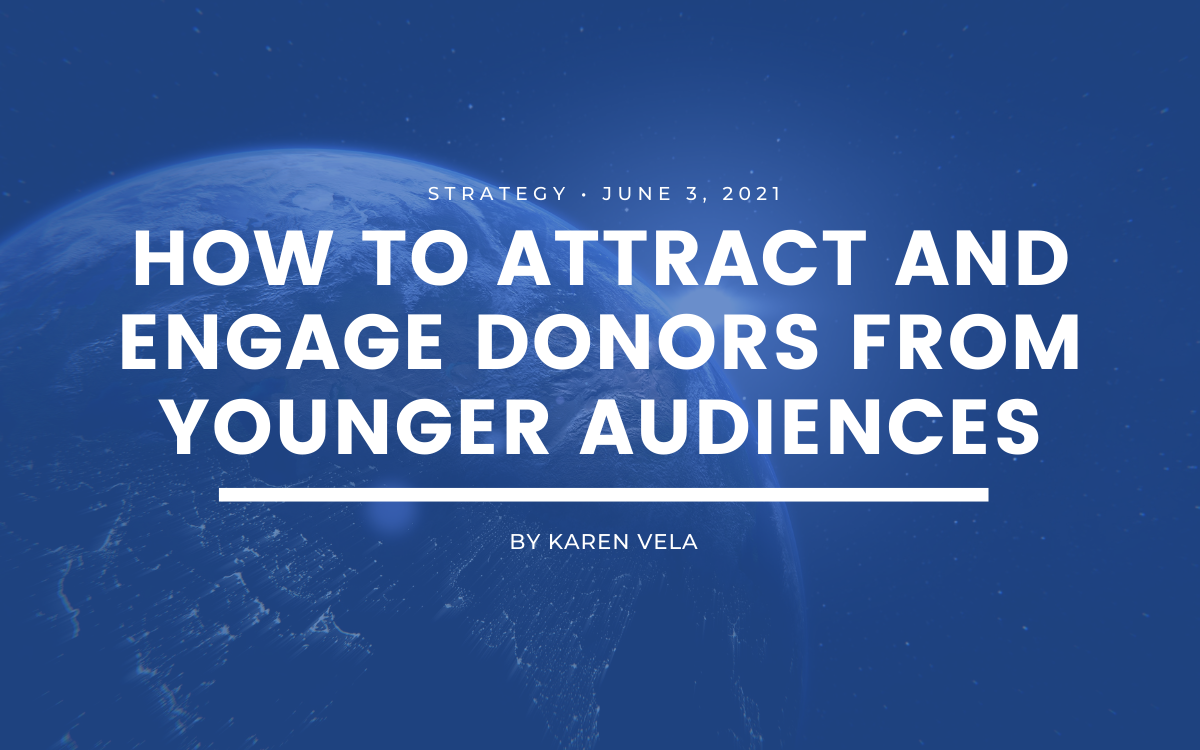How to Attract and Engage Donors from Younger Audiences
6 min to read ✭ In this post, you’ll learn how to attract and engage with potential donors from younger audiences.
Young people are the future donors and supporters of your nonprofit organization. Targeting them can seem like a daunting task, but when we take a closer look at data about their characteristics, we can tailor our marketing strategy to focus on acquiring new young donors, and it has been proven to pay off!
Who Makes Up Younger Audiences?
Young people are classified into two generational groups: Millennials and Gen Z. Those born between 1981 and 1995 are considered Millennials and are now anywhere between 25 and 40 years old. Gen Z is younger and consists of those born between 1996 and 2010. This generation is dominated by tech-savvy teenagers and early adults. Studies have been done that can help us better understand these audiences and their tendencies. The more in-depth understanding we have of these groups, the better we can communicate and engage with them through our marketing strategies.
Characteristics of Younger Generations
Millennials and Gen Z have many generational differences, but there are some similarities when it comes to their interest in supporting nonprofit causes.
Passion for Activism
Younger generations have been found to be more passionate about activism and human rights. In a survey done by Irregular Labs on Gen Z from seven different countries, 75% of respondents said that being politically or socially engaged is very important to them. Millennials are also known to show strong support for causes they care most about like human rights, child development, and victims of crime/abuse. In 2018, Millennials were the most active demographic to donate to charities. Speaking of donating…
Interest in Donating
Both Gen Z and Millennials show strong interest in donating. According to research on Generational Giving done by Classy, 84% of millennials give to charities and 40% of them are enrolled in a recurring giving program. Although Gen Z is younger and may not have enough passive income to be as charitable as they desire, 30% have reported that they have made a donation to an organization.
Interest in Volunteering
Gen Z is often referred to as “Philanthroteens” for a reason. They have shown a passion for activism in more ways than just donating—they also want to volunteer. 26% of 16 to 19-year-olds practice volunteering on a regular basis, and more statistics back the fact that they want to make a difference, meaning they are a great group to target when looking to acquire volunteers. Millennials are quite similar, with 21.9% reporting that they do volunteer work.
We know that these are very large groups with Millennials alone taking up ¼ of the US population. Now that we know some crucial characteristics about these groups, it’s important to understand what this means for your nonprofit and your donor acquisition strategy.
Why Engaging Younger Audiences is Important
These groups have a burning desire to make the world a better place. Need another statistic to prove it? Thanks to research from Classy, we know that 76% of Gen Z is worried about the planet, 60% of Gen Z would prefer to work for a company that wants to make a difference, and 1 in 10 people in Gen Z want to start their own nonprofit organization someday! The odds are in your favor, and this makes Gen Z the low-hanging fruit for your new donor goals.
Most nonprofits will overlook the opportunity to market to young people based solely on the fact that they are not as wealthy as Baby Boomers. Although that is true, these groups offer benefits in the form of activism, social media influence, and volunteer time. If you know how to attract these types of donors, you can build strong relationships and as these people grow older they will become long-term supporters of your cause.
How to Engage Younger Audiences
So how exactly can your nonprofit gain the attention of young people? Show up where they spend the most time, communicate your message effectively, and stay authentic and relevant. Let’s get more specific.
Use the Most Effective Channels
The most effective channels to target younger audiences are social media and email. Gen Zers have practically grown up with a phone in their hands, and according to Hootsuite, a whopping 88% of them are actively using social media. Target them where they’re already looking by building a strong social media strategy. Research shows that Gen Zers have a high tolerance for ads, and are less bothered by them than older people which means utilizing paid social ads could be beneficial. Use social media for awareness by reporting on news, drive action by encouraging direct responses, and communicate efficiently by engaging regularly with your community. Lastly, influencer marketing is a strategy worth looking into as a way to raise awareness about your organization and target specific viewers that you know are interested in your cause.
Email marketing is not dead! Young donors check their email, and they are most likely going to read your email on their mobile device. Use email marketing campaigns to communicate with these audiences, and make sure your layout is mobile-friendly with short and concise copy.
Go Virtual and Go Mobile
Virtual fundraising and online donations are here to stay. All of your fundraising campaigns absolutely need to include an online donation component. This online component should also be easily accessible from a mobile device. Believe it or not, data collected from Classy shows that 25% of Millennials use their phones to complete donations and search for new nonprofits to support. Make sure your website design is 100% mobile-friendly by having easy navigation tools with visually engaging content. These generations are visually oriented, so capture their attention with high-quality information and inspiring video content. The goal is to make it as simple as possible for these digital natives to give!
Trust, Transparency, and Authenticity
Because younger people have grown up in the digital age, they can see right through inauthentic marketing. Be authentic with your marketing by personally catering to the interests and lifestyles of younger people. The actions of your organization will speak louder than words, so prove to your audience that your cause is worthy of their support. 60% of Millennials say that their decision to support a nonprofit with a donation hinges greatly on whether they can see their gift’s impact. With that in mind, clearly demonstrate your organization’s impact across your website, via email campaigns, and across social media platforms. Being personal, intentional, honest, and authentic will build trust and resonate with younger people.
Encourage Volunteering and Run Peer-to-Peer Fundraisers
We already know that these groups have the interest and desire to spend time volunteering. If your organization actively seeks volunteers, target these people through the most effective marketing channels mentioned above. Let them know you need their help! Volunteer opportunities are also a great way to build loyalty with younger people, as they may turn into a recurring volunteer for years to come, and they’re likely to bring friends with them.
If your organization doesn’t already utilize P2P fundraising strategies, it may be time to start. Gen Z and Millennials are the most connected people due to their heavy usage of digital devices and social media. Take advantage of this by launching a P2P campaign that encourages donors to involve their own personal circles of friends and family. The fact that these groups are inclined to make the world a better place, they’re always connected to others online, and they have an interest in donating makes them perfect candidates for participating in a P2P fundraising effort.
Young Donor Retention
Now that you’ve engaged and interacted with new young donors, your job isn’t quite over yet. Turn these new donors into loyal supporters, regular volunteers, and recurring givers. A few ways to do this are to build a community by hosting events, showing immense gratitude, and by giving them a voice. Give the “philanthroteens” a role within your organization by creating a junior board or offering leadership roles for those that are the most involved. These are just a few ways to foster and grow long-lasting relationships with young supporters.





